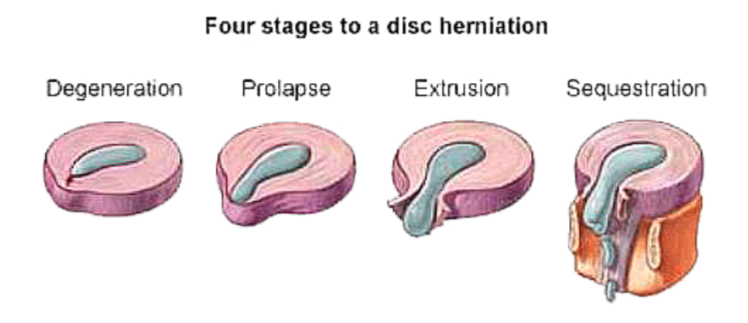Spinal Disc Herniation
Altamonte Springs, Florida
Spinal discs are made up of a tough, fibrous, outer ring of tissue called the annulus that protects a soft gel-like interior. Disc Herniations are generally due to age-related degeneration, poor posture, lifting injuries, repetitive spinal strain, and trauma. When stress is placed on the spine where a disc is injured or deteriorated, a tear or rupture in the the disc’s outer ring can allow the soft center fluid to bulge outward. If some of the gel-like fluid escapes the outer most layer of the ring and presses on the spinal cord or nerve roots, it can trigger back pain, neck pain, and nerve pain that can radiate down the arms or legs and into the hands or feet. The severity of pain and symptoms of a Disc Herniation will depend upon the stage of herniation and the specific nerve root upon which it is impinging. There are four stages of Disc Herniation:
- Degeneration/Bulging Disc is considered a contained injury in that there is no rupture within the outermost layer of the disc (annulus). A small portion of the soft center protrudes outward but does not leak out of the fibrous outer ring.
- Prolapsed Disc is the next progression of a disc herniation where more of the gel-like center seeps through a weakened or torn region of the annulus and may displace sufficiently to press on nearby muscles, ligaments, and nerves causing debilitating pain and weakness.
- Disc Extrusion is a non-contained injury where there is a rupture in a region of the annulus and the gel-like center of the disc is leaked into the spinal canal where nerve root irritation or compression can cause pain, numbness, tingling, muscle weakness, and other debilitating symptoms.
- Disc Sequestration occurs when there is a complete rupture of the annulus and the gel-like fluid escapes through the tear, moves into the spinal canal, and separates from the disc altogether. This type of herniation causes the most serious pain syndromes and can lead to paralysis as a result of compression of the spinal canal by the sequestered disc. In this case, surgery is usually the recommended method of intervention.



